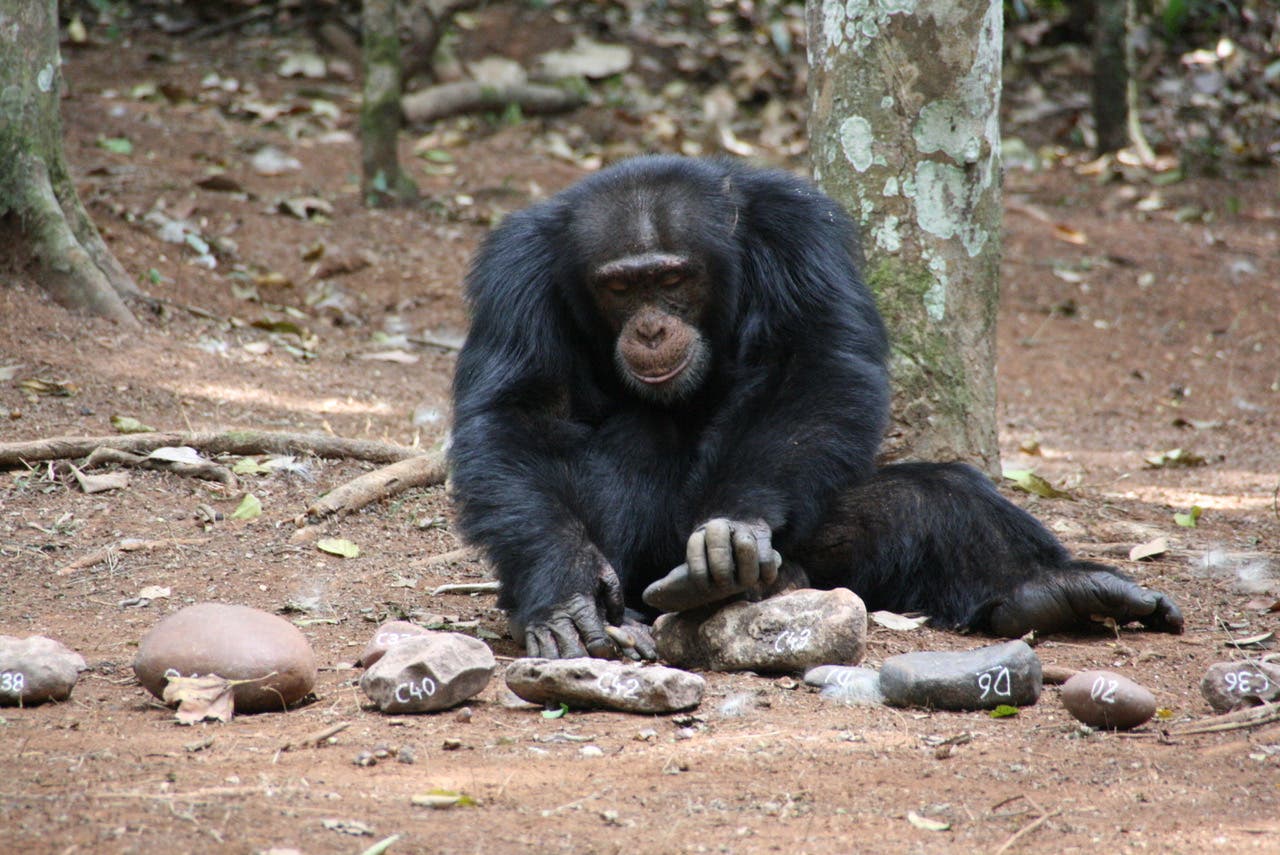Surprising link between chimpanzee tool use and human evolution
Understanding the ways humans and animals organize and execute complex sequences of behavior sheds light on the evolution of cognition. Sequential behaviors, such as language, music, and tool use, reveal…

A male individual cracking nuts using stones. (CREDIT: Dora Biro)
Understanding the ways humans and animals organize and execute complex sequences of behavior sheds light on the evolution of cognition. Sequential behaviors, such as language, music, and tool use, reveal intricate patterns of organization.
Humans excel at forming hierarchical structures and recognizing nonadjacent dependencies, where relationships between actions or elements persist despite intervening steps. This ability underpins countless activities, from constructing sentences to crafting tools.
Language is a prime example of hierarchical organization. Words form phrases, phrases create sentences, and sentences convey thoughts. Embedded clauses within sentences illustrate nonadjacent dependencies.
For instance, in "The weather [outside the window] is horrible," the verb “is” and adjective “horrible” connect to the noun “weather,” bypassing the intervening phrase “outside the window.” This principle extends beyond language to music and action sequences.
In opening a locked door, actions such as grasping and turning the handle may be interrupted by unlocking it, demonstrating the embedding of subgoals.
While human behaviors display these complex structures, whether animals exhibit similar patterns has been debated. Traditional models suggested animals follow reflexive chains, where each action triggers the next, requiring minimal memory.
These sequences were often described using Markov chains, where transitions depend only on the immediately preceding action. However, growing evidence indicates some animal behaviors, particularly in species like whales, birds, and primates, include hierarchical organization and nonadjacent dependencies.
Whales’ songs and birds’ calls sometimes reveal nested structures, while baboons perceive hierarchical social relationships. Chimpanzees, one of humans’ closest relatives, demonstrate complex social games and vocalizations.
Related Stories
For behaviors like birdsong, nonadjacent dependencies span distances predicted by hierarchical organization. Still, many animals rely on simpler, Markovian systems, emphasizing adjacent relationships. Further research is needed to determine the extent and contexts of animals’ hierarchical abilities, particularly in species closely related to humans.
Chimpanzee tool use offers compelling evidence of hierarchical behavior. In the wild, chimpanzees use tools to crack nuts, a complex task involving hammers and anvils. Observations suggest these actions are not reflexive but organized into subgoals and subroutines.
For instance, a chimpanzee might grasp a nut, position it on an anvil, and strike it with a hammer. If adjustments are needed, they interrupt and resume the sequence, showing flexibility.
Qualitative descriptions of such behaviors have long implied hierarchical organization. However, these accounts risk subjective bias. Even apparent hierarchies might emerge from simpler mechanisms.
To address this, researchers employed mutual information (MI) decay models, a quantitative method for assessing sequence organization. MI measures predictability within a sequence, with hierarchical structures exhibiting slower decay over longer distances compared to Markovian systems.
In a recent study, scientists analyzed over 8,000 tool-use actions performed by West-African chimpanzees in Guinea’s Bossou forest. Video recordings captured sequences during nut-cracking, allowing researchers to examine dependencies across actions.
They found that two-thirds of the adult chimpanzees’ actions showed long-range dependencies surpassing those expected from Markov models. Even after accounting for repeated actions, dependencies persisted in half the individuals, indicating genuine hierarchical organization.
The study revealed variation among chimpanzees. Some displayed strong hierarchical patterns, while others relied more on local dependencies. These differences suggest individual strategies and cognitive flexibility. Lead researcher Dr. Elliot Howard-Spink noted, “Our results suggest that the fundamental aspects of human sequential behaviors may have evolved prior to the last common ancestor of humans and chimpanzees.”
Hierarchical behavior offers adaptive advantages. It allows individuals to adjust sequences based on context, such as skipping unnecessary steps or embedding additional actions. For example, a chimpanzee might skip puncturing a termite mound if it’s already accessible. This flexibility contrasts with fixed action patterns, where sequences are rigidly followed.
The researchers also found parallels between chimpanzees and humans in chunking—grouping actions into higher-order units. Humans use this strategy in language and tasks, simplifying complex sequences. Similarly, chimpanzees’ tool use suggests they plan and organize actions into repeatable chunks. Professor Thibaud Gruber emphasized, “The ability to flexibly organize individual actions into tool use sequences has likely been key to humans’ global success.”
Despite these findings, questions remain. Not all chimpanzees exhibited hierarchical organization, and the extent to which these behaviors are universal among great apes is unclear. Further research could explore whether such abilities are innate or develop through learning and social interactions. Understanding how chimpanzees group actions into chunks may clarify the rules governing their sequences and the cognitive mechanisms involved.
Comparing chimpanzees’ behaviors to those of other primates and animals could illuminate evolutionary trends. If great apes share similar hierarchical capacities, this might suggest a shared ancestral trait. Moreover, investigating how young chimpanzees develop these skills could reveal the interplay of genetics and environment.
The implications of this research extend beyond understanding chimpanzee cognition. They contribute to debates about the co-evolution of language and tool use in humans. Language and technology both rely on hierarchical structuring, suggesting a potential shared evolutionary origin.
Professor Dora Biro highlighted, “Our work underscores the need to preserve wild chimpanzees and their cultural behaviors, which are critically endangered.” Conservation efforts could benefit from recognizing the importance of protecting these cultural practices.
This study also exemplifies the role of interdisciplinary collaboration in advancing knowledge. Researchers from institutions across the globe combined expertise in biology, anthropology, and computational modeling. By applying statistical models to long-term observational data, they uncovered new insights into the organization of chimpanzee tool use.
Future studies aim to refine these findings and explore broader contexts. Investigating how chimpanzees’ sequential actions compare to those of other animals could clarify the uniqueness of these behaviors. Additionally, examining the neural basis of sequence generation in primates may reveal connections to human cognition.
Understanding how animals organize behaviors sheds light on the origins of human complexity. This research not only bridges the gap between humans and animals but also highlights the cognitive sophistication of our closest relatives.
As we continue to uncover the intricacies of animal behavior, we gain a deeper appreciation for the shared evolutionary roots of intelligence and culture.
Note: Materials provided above by The Brighter Side of News. Content may be edited for style and length.
Like these kind of feel good stories? Get The Brighter Side of News' newsletter.
Rebecca Shavit
Science & Technology Journalist | Innovation Storyteller
Based in Los Angeles, Rebecca Shavit is a dedicated science and technology journalist who writes for The Brighter Side of News, an online publication committed to highlighting positive and transformative stories from around the world. With a passion for uncovering groundbreaking discoveries and innovations, she brings to light the scientific advancements shaping a better future. Her reporting spans a wide range of topics, from cutting-edge medical breakthroughs and artificial intelligence to green technology and space exploration. With a keen ability to translate complex concepts into engaging and accessible stories, she makes science and innovation relatable to a broad audience.



